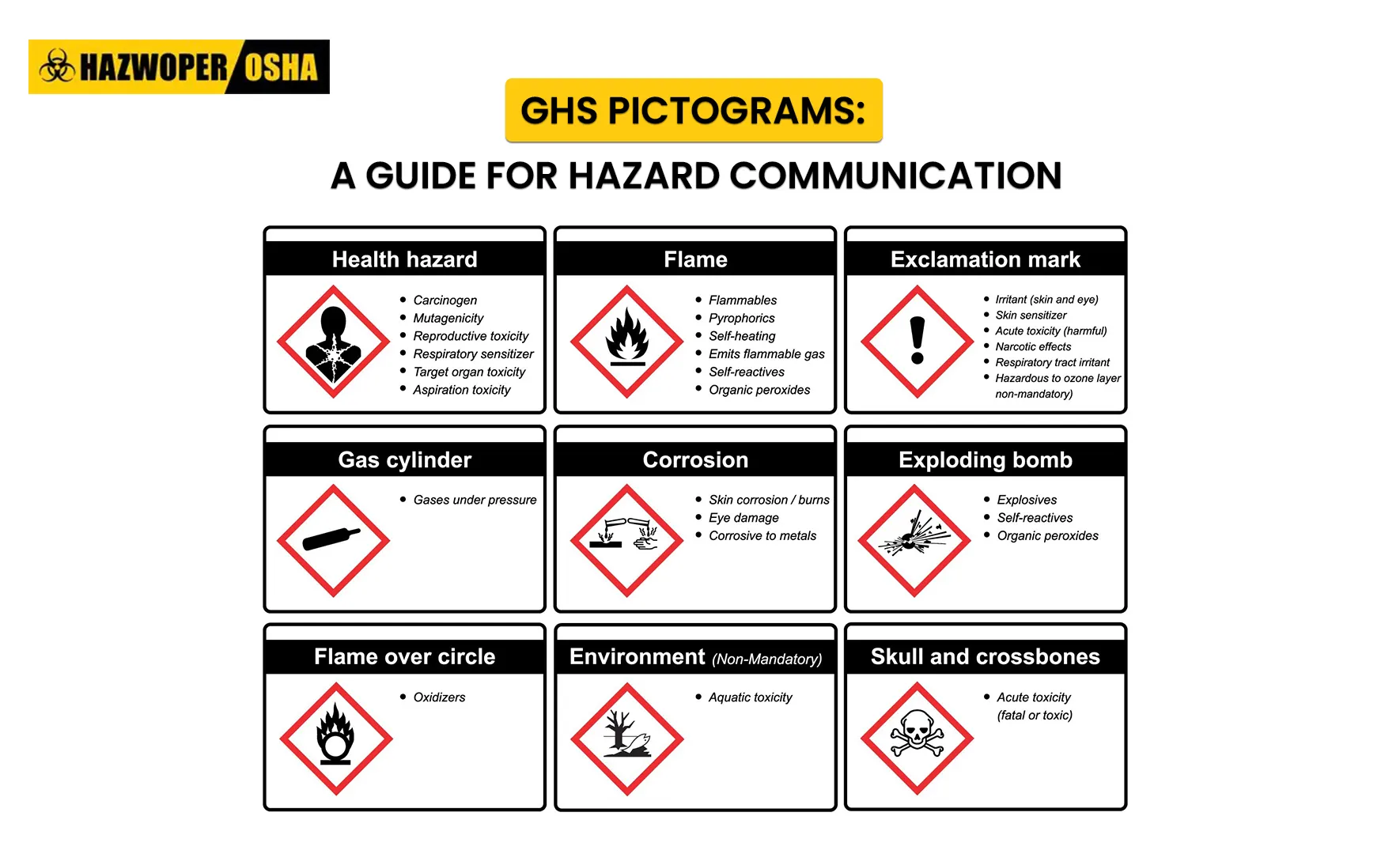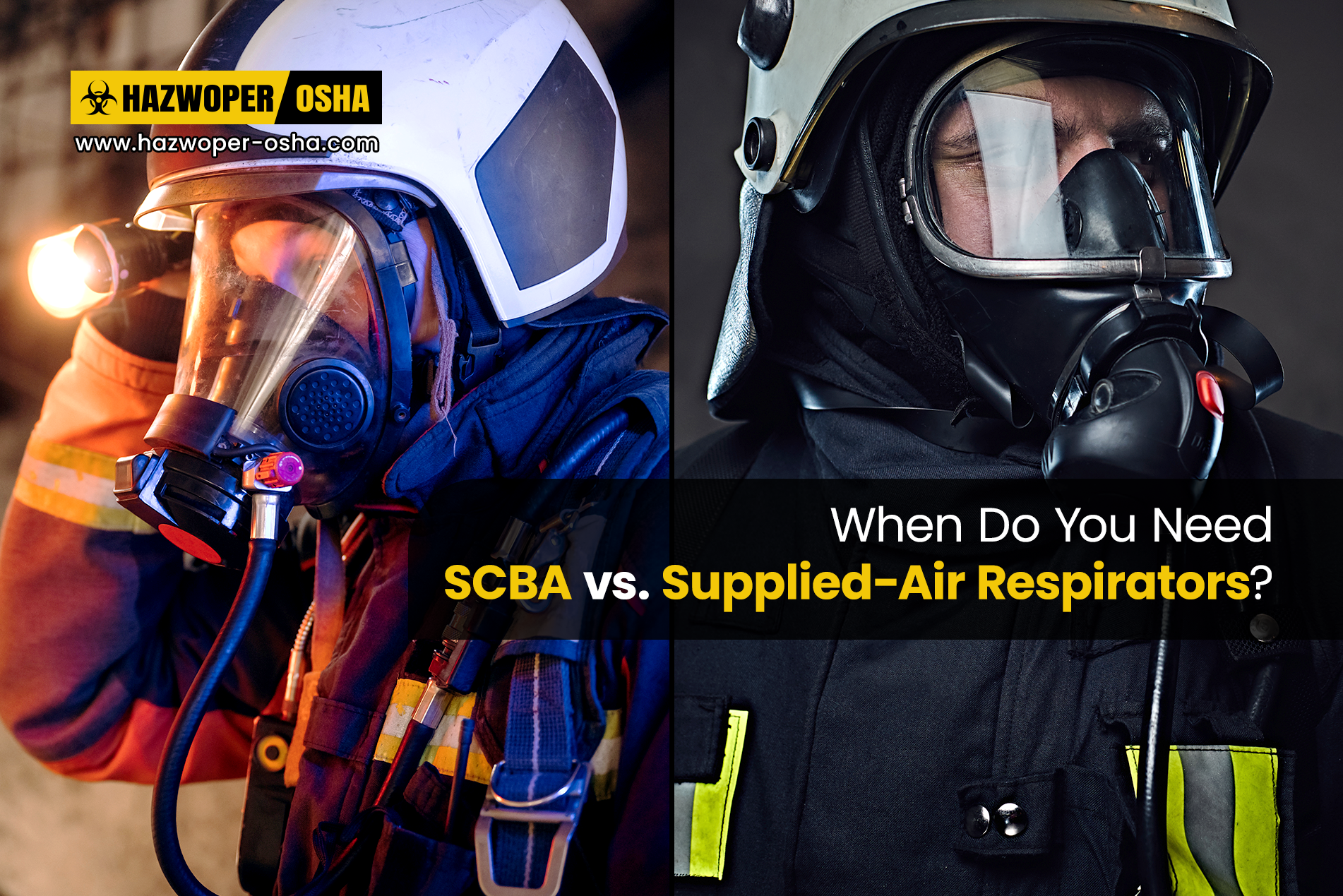GHS Pictograms: A Guide for Hazard Communication
The Globally Harmonized System of Classification and Labeling of Chemicals (GHS) is a key component in the field of occupational safety. Understanding GHS and its related pictograms is essential for both employers and employees, as it is a framework that enables the standardization of chemical hazard classification and communication in the global arena. GHS is supported by regulatory agencies worldwide, including the Occupational Safety and Health Administration (OSHA) operating in the USA which aligned its Hazard Communication Standard (HazCom, HCS) with the GHS in 2012.
To get a more in-depth understanding of the link between GHS and the HazCom Standard, read our blog on What is GHS and What is its Connection with OSHA’s Hazard Communication Standard?
The goal of the GHS is simple — to protect people and the environment from injuries and illnesses associated with using hazardous chemicals in the workplace. Together with OSHA’s emphasis on worker rights and their right to know, be informed of, and comprehend the dangers and identities of the chemicals to which they are exposed at the workplace, GHS pictograms play a critical role in enhancing worker and workplace safety.
To support employers in meeting OSHA’s General Duty clause and fulfill training requirements mandated by OSHA, we have developed an online safety training course on Hazard Communication (HazCom) with the Globally Harmonized System (GHS). This training course is one of the best for training employees by many leading industries according to feedback and reviews received. The course offers a summary of the modifications implemented in OSHA's HazCom Standard, encompassing the revised label components and the format of Safety Data Sheets (SDSs), following GHS. Participants will also acquire the ability to interpret labels and locate relevant information within the different sections of SDS.
GHS - A Summary
Let us first understand what the Globally Harmonized System of Classification and Labeling of Chemicals (GHS) is.
GHS, often referred to as the "Purple Book," serves as a globally accepted standard for classifying and communicating chemical hazards. Adopted by OSHA in the United States, GHS aims to standardize hazard communication elements, ensuring a consistent approach to identifying and communicating hazards across borders.
The Core Components of GHS
Fundamentally, GHS combines several important features, including SDSs, standardized label elements, hazard categorization criteria, and its renowned pictograms. Together, these components support workplace communication of hazards aligned to OSHA’s Hazard Communication Standard.
GHS Pictograms
The GHS pictograms are visual representations intended to quickly communicate precise information about a chemical product's dangers. These symbols act as a universal language, bridging and serving the language gaps and ensuring that workers anywhere can easily understand and comprehend any possible risk associated with a material.
GHS pictograms are divided into nine standard symbols, each representing distinct hazard categories that are widely utilized. From explosive materials to health hazards, the pictograms offer a quick and clear indication of the potential dangers associated with a particular chemical. The nine pictograms are diamond-shaped, meaning they are square and oriented at a 45-degree angle, with a black symbol on a white background. Their borders are either black or crimson. Shown below is a summary of these GHS pictograms.

Now let us delve into these GHS pictogram categories in details:
1. Health Hazard:
The health hazard pictogram indicates substances that may cause chronic health effects, such as carcinogenicity, reproductive toxicity, respiratory sensitization, or target organ toxicity. Prolonged exposure to these materials may lead to serious health issues.
2. Flame:
The flame pictogram signifies materials that can catch fire easily when exposed to an open flame or heat source. This includes gasses, liquids, and solids that may ignite and burn rapidly. Flammable substances pose a fire hazard and require careful handling and storage.
3. Exclamation Mark:
The exclamation mark GHS pictogram is used to indicate a health hazard. This symbol warns of substances or mixtures that may cause less severe health effects or damage; such as irritants (skin and eye), skin sensitizers, acute toxicity, narcotic effects, respiratory tract irritants, and those hazardous to the ozone layer.
4. Gas Cylinder:
The gas cylinder pictogram is assigned to substances stored under pressure. These could include gasses that are liquefied, dissolved, or compressed. Handling and storage must adhere to strict safety guidelines to prevent leaks, ruptures, or other hazards associated with pressurized containers.
5. Corrosion:
The corrosion pictogram signifies substances that can cause damage to living tissues, metals, or other materials upon contact. Corrosive materials may include strong acids or bases and require careful handling to avoid skin burns or damage to equipment.
6. Exploding Bombs:
The exploding bomb pictogram is indicative of substances or mixtures that can cause an explosion. This includes materials that are highly reactive and can release energy suddenly and violently. Such hazards pose a significant risk to both personnel and the surrounding environment.
7. Flame Over Circle:
This pictogram denotes substances that provide oxygen and can enhance the combustion of other materials. These materials can intensify fires and pose a risk if they encounter flammable or combustible substances. Proper storage and handling precautions are crucial. For example, this flame over circle pictogram may be used to depict physical hazards like oxidizing liquids or oxidizing solids.
8. Environment:
The environmental hazard pictogram is used for substances that pose a risk to aquatic life, soil, or the atmosphere. These materials may have long-lasting effects on ecosystems, and their release should be minimized to protect the environment.
9. Skull and Crossbones:
The skull and crossbones symbol indicates that hazardous products with this pictogram can cause death or poisoning.
To maintain a safe workplace environment, both employers and employees must comprehend these GHS pictograms. To reduce the dangers connected with these different hazards, it is essential to follow safety requirements, properly label products, and receive the necessary training.
Other Significant Elements of GHS Labels
Signal Word
Recall that these pictograms are a component of the larger GHS system, highlighting the significance of an international standard for hazard communication.
In addition to these symbols, every hazardous chemical is given a single "Signal Word" under the GHS, which can be either WARNING or DANGER depending on the hazard class. A chemical is only given ONE signal word since these words are meant to convey the seriousness of a hazard rapidly. Labels must contain the required signal words.
For more severe threats, the word DANGER is used; for less serious hazards, the word WARNING is used. Signal words are always written in uppercase, bold letters.
Precautionary Statements
While we are looking into GHS pictograms let’s not forget the importance of precautionary statements. The hazard statement and GHS pictograms are supported by precautionary statements, which can help you with:
- Avoiding chemical mishaps and exposure while receiving and grounding equipment.
- Handling chemical crisis.
- Safely keep the chemicals with statements like, “Keep in an area with good ventilation”.
- Getting rid of the chemical safely (e.g., P501: Follow local, regional, and federal rules for getting rid of contents or containers)
The core part of precautionary statements should be displayed in bold print and additional information in plain text. Precautionary statements are as follows:
- Prevention: Instructions for safe use of chemical
- Response: Procedure to follow in case of chemical spilling or fire.
- Storage: Instructions for safe storage of chemicals.
- Disposal: Instructions for safe disposal of chemicals.
On chemical labels, precautionary remarks should be prominently displayed even though they aren't always related to hazard classes. They are useful when evaluating total hazards.
Navigating GHS in the US
As OSHA has integrated GHS into its HCS Standard, to ensure consistency in hazard communication both nationally and internationally, employers and employees must have adequate knowledge to communicate information about the hazards of chemical products in the workplace.
Thus, following the GHS system is not only a best practice for organizations and employees in the US, but it's also required by regulations. By using GHS labeling standards, employers and employees are better positioned to enhance safety in their workplace while contributing to industry-wide standardization of hazard communication, ultimately fostering a safer working environment.
Safety should be the highest priority. With its standardized method of communicating hazards, GHS offers a strong foundation to both companies and employees. Businesses can more effectively manage the intricacies of chemical dangers by being familiar with GHS pictograms and classifications, which promotes a safer and healthier work environment.
2024 GHS Updates: What You Need to Know
In May 2024, OSHA finalized an update to the Hazard Communication Standard (HCS), aligning it with GHS Revision 7 and select elements of Revision 8. The changes, effective July 19, 2024, aim to improve clarity and consistency in hazard communication.
Key Updates:
-
New Hazard Classes
-
Includes desensitized explosives, chemicals under pressure, and non-flammable aerosols
-
Flammable gases now categorized into 1A and 1B
-
Labeling for Small Containers
-
Containers ≤100 mL: simplified label allowed with full info on outer packaging
-
Containers ≤3 mL: only product identifier required on container
-
SDS Changes
-
Additional detail required in Sections 2, 3, 9, and 11
-
New concentration range limits for trade secret disclosures
-
Definitions and Precautionary Statements
-
Revised terminology (e.g., “bulk shipment,” “PLHCP”)
-
Updated and clarified safety phrases
Compliance Deadlines:
-
Substances
-
Manufacturers: by January 19, 2026
-
Employers: by July 20, 2026
-
Mixtures
-
Manufacturers: by July 19, 2027
-
Employers: by January 19, 2028
References:
UNECE. (2019). GHS (Rev.8) (2019). Globally Harmonized System of Classification and Labelling of Chemicals (GHS). Website. https://unece.org/ghs-rev8-2019
OSHA. (n.d.). Hazard Communication. Website. https://www.osha.gov/hazcom
UNECE. (2023). Globally Harmonized System of Classification and Labelling of Chemicals (GHS Rev. 10, 2023). Website. https://unece.org/transport/dangerous-goods/ghs-rev10-2023

 EN |
EN |  ES
ES



























































































































